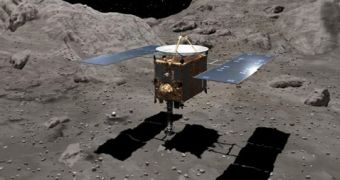JAXA, the Japanese Space Agency announced today that Hayabusa, the spacecraft that touched the surface of asteroid Itokawa and came back to Earth, successfully brought back the first samples ever collected from the surface of an asteroid.
The samples are small dust grains collected from asteroid Itokawa in 2005, and brought back by Hayabusa in June.
The spacecraft made a 1.25 billion-mile (2 billion-kilometer) trip and it took Hayabusa seven years to complete it.
The dust sample was found inside the return capsule that landed in Australia, that was flown back to Japan for analysis.
JAXA researchers used a scanning electron microscope in order to study the asteroid samples, and they found traces of minerals like olivine, pyroxene and others.
These minerals match the observations made by Hayabusa when it visited the asteroid, SPACE.com reports.
Most dust particles are 10 micrometers large, almost one tenth of the width of the human hair.
Officials from JAXA said that the particles were found in one of the two compartments inside the Hayabusa sample return capsule.
They added that “JAXA is developing the necessary handling techniques and preparing the associated equipment for the initial (but more detailed) analysis of these ultra-minute particles.
“About 1,500 grains were identified as rocky particles, and most of them were judged to be of extraterrestrial origin, and definitely from Asteroid Itokawa," the Japan Aerospace Exploration Agency declared.
JAXA scientists knew that Hayabusa came back with material particles since July, but they were uncertain that the particles were actually from the asteroid, and not cosmic dust or contaminants from Earth.
It is all clear now, they said: the Hayabusa spacecraft really collected samples of an asteroid.
Hayabusa project manager Junichiro Kawaguchi told Japan's Mainichi Daily News that “being able to retrieve material from a celestial body beyond Earth was more than we had hoped for.
“When the capsule returned, I said, 'Just having it return is like a dream,' so I don't know how to express this, which was beyond my dreams.”
Hayabusa bringing home asteroid dust is the ultimate justification for Japan's mission team.
“I'm filled with emotion and I can't believe it; a long period of hard work has paid off,” Kawaguchi said.
The success of this mission justifies JAXA's follow-up mission – Hayabusa 2, which is planned for launch in 2014.
It should reach a carbon-rich asteroid in 2018 and return samples to Earth by 2020.

 14 DAY TRIAL //
14 DAY TRIAL //